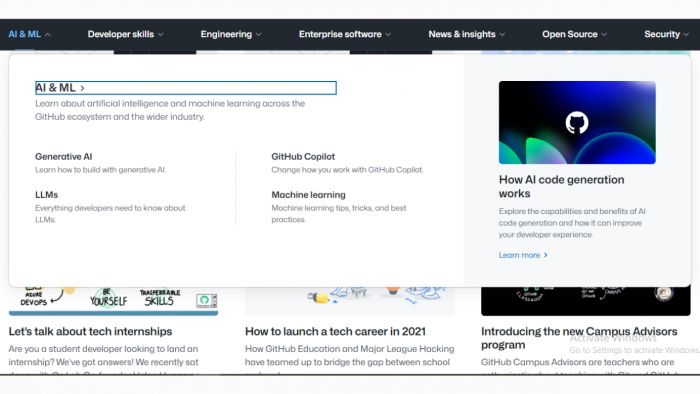On This Page
- Why GitHub Matters for Your Career
- Step 1: Make Your Profile Shine
- Step 2: Build a Portfolio of Projects
- Step 3: Contribute to Open Source
- Step 4: Show Consistency, Not Just Volume
- Step 5: Engage with the Community
- Step 6: Use GitHub for Technical Interviews
- Step 7: Leverage GitHub Actions and CI/CD
- Step 8: Showcase Learning and Growth
- Real-World Examples of GitHub Helping Careers
- Career Growth Starts Here
When I first created a GitHub account, I treated it like a storage locker for my code. Over time, I realized GitHub can be much more than that. It’s not just for version control or collaboration; it’s a portfolio, a resume enhancer, and even a networking platform. If you want to grow your career in tech, GitHub can be one of the most powerful tools at your disposal.
In this post, I’ll share how you can use GitHub strategically to stand out, build credibility, and unlock new career opportunities.
Why GitHub Matters for Your Career
So why should you care about GitHub when you already have LinkedIn or a traditional resume? The answer is simple: proof of work.
Recruiters and hiring managers want to see what you can do, not just what you say you can do. According to a 2022 Stack Overflow survey, more than 50% of developers say they got a job or interview because of their GitHub profile (source). GitHub acts like a live portfolio that demonstrates your skills in real time.
Think of it this way: LinkedIn tells people what you’ve done, but GitHub shows them how you work.
Step 1: Make Your Profile Shine
First impressions matter, and your GitHub profile is often the first thing a recruiter will see. Treat it like your personal brand page.
Here are a few tips:
- Profile README: Write a short introduction. Mention who you are, your interests, and what you’re working on. Tools like GitHub Profile README Generator can help.
- Pinned Repositories: Choose 4–6 projects that best represent your skills. Highlight diversity, one in web development, one in data science, maybe one open-source contribution.
- Professional Photo: It adds credibility.
Ask yourself: If a stranger landed on my profile, could they immediately tell what I do and what I’m good at?
Step 2: Build a Portfolio of Projects
Your GitHub should tell a story. Instead of uploading random files, curate projects that show skills relevant to the career path you’re targeting.
Examples:
- Web developer → Full-stack app with React + Node.js.
- Data analyst → Jupyter notebooks with data cleaning, visualization, and storytelling.
- AI/ML engineer → Machine learning model with documentation and deployment.
Don’t just stop at the code. Add a README with:
- What the project does
- Why did you build it
- How to use it
- Key results or metrics
This makes your project understandable for non-technical reviewers too.

Step 3: Contribute to Open Source
This is one of the most underrated ways to grow on GitHub. Contributing to open source shows collaboration, problem-solving, and initiative.
But how do you start?
- Look for beginner-friendly repos on First Contributions or Good First Issues.
- Fix documentation errors, improve test cases, or solve minor bugs.
- Gradually move into bigger contributions.
- Companies love to see open-source work because it proves you can work in teams and handle real-world codebases.
Step 4: Show Consistency, Not Just Volume
Recruiters don’t expect you to push code every day, but they do notice consistency.
A steady commit history (say, weekly or monthly) looks better than a profile with one giant burst and then silence. It signals discipline and ongoing learning.
Tip: Use GitHub Projects or Issues to track your goals. This shows you’re organized, which employers value.
Step 5: Engage with the Community
GitHub is not just about code; it’s a social network for developers.
Ways to engage:
- Star repositories you find useful.
- Follow developers in your field.
- Comment on issues with helpful insights.
- Create discussions around your projects.
Networking on GitHub can lead to collaborations, mentorship, and even job referrals.
Step 6: Use GitHub for Technical Interviews
Many companies now ask for a GitHub link instead of a portfolio. Here’s how to prepare:
- Pin relevant repos based on the job role.
- Show clean commits with descriptive messages.
- Add tests to demonstrate code quality.
- Document your thinking so interviewers see how you approach problems.
Some recruiters even check GitHub contribution graphs as part of candidate evaluation. A well-maintained profile can directly improve your chances.
Step 7: Leverage GitHub Actions and CI/CD
Want to stand out from the crowd? Automate.
GitHub Actions lets you set up CI/CD pipelines, run tests, or deploy projects automatically. Employers love candidates who know DevOps basics, even if they’re not applying for DevOps roles.
Adding this to your projects shows you can write production-ready code, not just toy projects.
Step 8: Showcase Learning and Growth
Don’t worry if you’re not an expert yet. GitHub is also a great way to show your learning journey.
Create repos for:
- Code challenges from sites like LeetCode or Advent of Code.
- Notes from courses you take.
- Mini-projects exploring new frameworks.
Employers like to see curiosity and growth. Your GitHub doesn’t need to be perfect; it needs to be authentic.
Real-World Examples of GitHub Helping Careers
- A frontend developer in Berlin landed a job at a startup after the recruiter found his GitHub blog template project, which had 200+ stars.
- A data scientist in India used GitHub to publish Kaggle notebooks and got noticed by a U.S. research lab.
- An ML engineer in Canada contributed to TensorFlow, which directly led to a referral at Google.
These stories aren’t rare. GitHub visibility can open doors you didn’t even know existed.
Career Growth Starts Here
GitHub is not just a tool for storing code; it’s your public resume, portfolio, and career accelerator. By polishing your profile, curating meaningful projects, contributing to open source, and engaging with the community, you create living proof of your abilities.
The best part? Unlike a resume that goes stale, GitHub grows with you. Every commit, contribution, or project adds to your career story.
So next time you push code, remember: it’s not just for version control, it’s for career growth.
Post Comment
Be the first to post comment!





